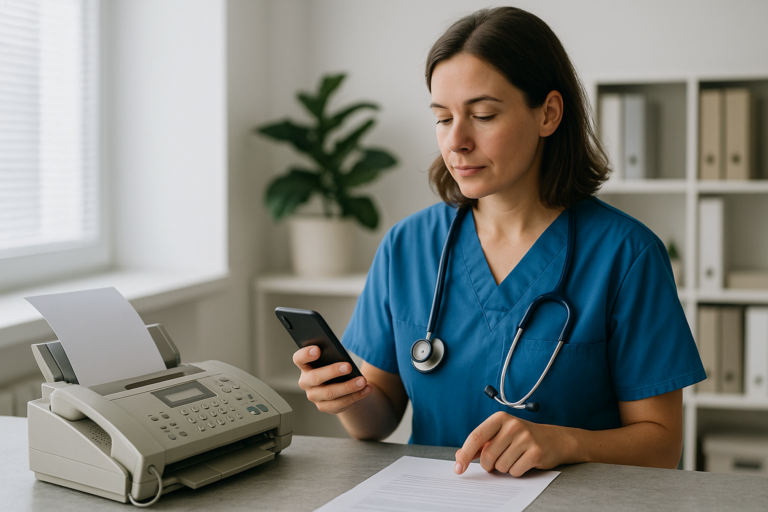Healthcare spending in the United States declined two percent in 2020 as a result of the COVID-19 pandemic. According to the American Hospital Association (AHA), this is the first decline in annual health spending since at least 1960, when the U.S. government began tracking it.
However, the country still spends approximately $3.8 trillion annually on healthcare, and the national healthcare expenditure (NHE) is estimated to reach $6.2 trillion by 2028. As noted by the Commonwealth Fund, the U.S. spends more on healthcare as a share of the economy than any other country.
Reducing Healthcare Waste Through Streamlined Workflows
A sizable part of America’s high healthcare spending is due to financial waste, which costs the system $760 billion to $935 billion annually. Healthcare waste comes in the form of overuse of services and a lack of interoperability and productivity.
A contributing factor to this waste is interoperability and productivity. Roughly 40 percent of clinical office work involves redundant tasks and wasted effort. These types of inefficiencies reduce productivity, negatively affect the bottom line and frustrate patients, staff and physicians.
Research assessing health IT implementations demonstrates that delays in patient care, billing, and communication are likely to occur if workflow is not taken into account. Inefficiencies in clinical and non-clinical staff workflows result in less than optimal resource utilization.
Healthcare providers of all sizes that implement technology and other solutions to streamline workflow, though, have the potential to reduce waste, especially for administrative tasks that don’t directly affect patient care. Effective workflow management has been shown to reduce the potential for medical errors, help to ensure compliance with industry regulations such as HIPAA and improve the quality of care provided to patients.
A recommended method for improving healthcare workflow is automation. Of the $372 billion spent on administrative complexity with the U.S. healthcare system, an additional $16.3 billion could be saved through workflow automation
Employing Mobile Technology for Care Collaboration and Automating Administrative Tasks
The amount of health data being created is growing at a 48 percent rate annually. A majority of data in the healthcare industry is increasingly being generated by the use of mobile technology, which enables providers to more easily and accurately communicate with patients, collect bedside data, conduct telehealth appointments, monitor data from remote devices and coordinate care continuity.
Mobile devices are used by various healthcare professionals, including physicians, nurses and other clinicians through on-demand data and applications can be delivered to any device over any secure network. The efficiency and mobility offered through these devices allow them to automate some administrative tasks and transmit patient data to other providers.
Roughly 80 percent of physicians use mobile technology as a standard part of their daily practice. It’s estimated that by 2022, 97 percent of all healthcare workers will depend on mobile devices for remote patient monitoring and patient health tracking to improve upon workplace efficiency and enhance patient care.
Implementing Tools and Strategies for Security
Although utilizing technology in healthcare offers providers a myriad of advantages, a lack of security measures can open them up to costly downtime, a damaged reputation, assorted fines and other problems. Healthcare enterprises are especially at risk for costly healthcare breaches because many of them create, receive or transmit protected health information (PHI). Plus, they’re required to comply with data storage and access regulations for the Payment Card Industry Data Security Standard (PCI-DSS) and Health Information Trust Alliance (HITRUST) Service Organization Control (SOC) certification standards.
A well-designed technology solution must address privacy and security concerns while promoting interoperability with other systems and tools. Many physician practices, hospitals and health systems use cloud computing because it allows for easier management of data security and offers less risk of costly downtime. By employing cloud-based technology, healthcare enterprises negate the need for a large IT staff to implement or maintain on-premise software and equipment, a cost savings that can be applied to solutions to maintain high-quality patient care.
RingRx makes it easy for healthcare providers to comply with HIPAA for all their communication needs, including phone calls, text messages and faxes as well as messages sent through our desktop and mobile applications. We achieve this by following strict protocols in these areas: physical security of PHI, encryption, training, product security and password protection, auditing and business associate agreements (BAAs). We also implement and manage multiple layers of security within our system to prevent any attempt of unauthorized access and external threats.
Check out our new white paper on how we help IT professionals deploy communications solutions that improve workflow and security and cut costs. Or, contact us to learn more!





